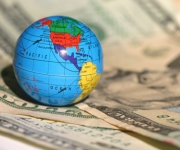Raj Patel has an interesting list of “things that aren’t as cheap as you think,” with an always-welcome reminder that many industries and social practices have costs that don’t appear in the sticker price. These “externalities” are offloaded to the public; they represent, in effect, enormous subsidies. Free marketeers hate market-distorting subsidies, right?
For the most part it’s a great list. To make it perfect I’d remove one and add one.
First, remove No. 5. Google, and the internet more generally, has actually prevented more carbon pollution than the 2 percent it directly produces — IT has large positive externalities. In their study “Information and Communication Technologies: The Power of Productivity,” scholars at the American Council for an Energy-Efficient Economy (ACEEE) reported:
For every extra kilowatt-hour of electricity that has been demanded by [information and communication technologies], the U.S. economy increased its overall energy savings by a factor of about 10. These productivity gains have resulted in significant net savings in both energy and economic costs. The extraordinary implication of this finding is that ICT provide a net savings of energy across our economy.
It should come as no surprise: ICT spreads and manages information. More and better information means more intelligence. More intelligence means more efficient use of resources, which means less waste. Carbon emissions are just that: waste. The whole project of sustainability is one of dematerialization, replacing stuff with intelligence, and ICT is our collective intelligence.
My addition to Patel’s list would remedy a glaring, disheartening omission. How could this not occur to someone specifically contemplating “cheaponomics”? Say it with me now: coal. From mining to transportation, washing, combustion, and post-combustion waste disposal, coal is an “assault on human health,” as the Physicians for Social Responsibility put it in a comprehensive recent study. (Others have called it “the enemy of the human race.”)
A study this year from the National Research Council, “Hidden Costs of Energy: Unpriced Consequences of Energy Production and Use,” found that coal-fired power plants impose $62 billion of health costs a year in the U.S. A 2005 analysis for the Ontario Ministry of Energy entitled “Cost Benefit Analysis: Replacing Ontario’s Coal-Fired Electricity Generation” (PDF) found that the direct health impacts of coal alone (to say nothing of climate change and environmental remediation) add a whopping 8 cents per kilowatt-hour to the cost. That puts it well above the price of its competitors. Neither of these studies took into account the impacts of mountaintop removal mining, combustion ash disposal, mercury emissions, or damage from climate change, all of which would push the price tag even higher.
And here’s the thing: each dollar invested in coal produces more external costs than the dollar before. The trend lines are all in the wrong direction. Even if carbon pollution can be handled by sequestration, refitted coal plants will need to burn more coal to get the same amount of power — that means more devastated mountains, polluted streams, asthma, lung cancer, heart disease, strokes, and mercury poisoning of pregnant mothers and fetuses.
In contrast, the costs of renewable energy technology are steadily declining as innovation, manufacturing efficiencies, and economies of scale increase. In short, it’s becoming clear that only a steady diet of federal subsidies — and maybe not even that — can protect the coal industry from a “perfect storm of competitive technology, stricter regulation and growing obsolescence.”
Kudos to Patel for surfacing the hidden costs of many things we take for granted. Let’s make sure coal takes its rightful place at the center of that conversation.



